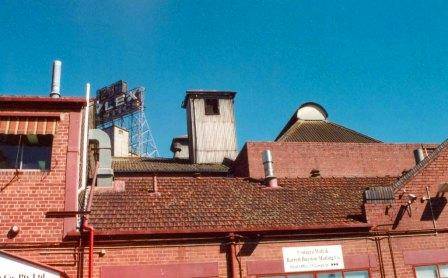| Back to search results » | Back to search page » |
|
The Cremorne Malting
Other NamesBarret Brothers & Burston Maltings , Smith Mcdonald & company , Smith Mitchell & Company , Smith, Winn & Fielding, Maltsters , Richmond Maltings , The Cremorne Brewery Location15 Gough Street,, CREMORNE VIC 3121 - Property No B7204
File NumberB7204LevelState |
|
Statement of Significance
What is significant? The whole of the malting works (and remnants of a former brewery) in the area bounded by Hoddle Street, Gough Street, Cremorne Street and Harcourt Street, with the exception of Buildings shown as H5 and G5 in the Conservation Management Plan, and the office of Barrett & Burston, a former malthouse, on the north side of Gough Street, which mirrors the two malthouses on the south side. While some of the walls on the site may date to an earlier brewery on the site, the buildings on the site date from the 1880 malthouse, and include extensive inter-war additions, and other mid twentieth century additions, including the c.1963 silos and associated Nylex Sign. The heritage fabric includes external signage and, potentially, archaeological sites.
How is it significant? The Richmond Maltings complex is significant for historic, scientific/technical, social and aesthetic/architectural reasons at the State level.
Why is it significant? It is historically significant as one of the few surviving malthouses in Victoria, the historical centre of Australia's malting industry. It is believed to be the oldest, largest and most intact purpose-built malthouse in Victoria. It is the only known maltings in Victoria with three traditional styled malthouses. Although these have been altered, it is the only maltings that is known to retain its distinctive malthouse roof-forms. It is the only surviving maltings known to have been associated with Mr Charles Smith (and likely, Mr J Gough), who had established the first maltings in Victoria (Lennox Street Richmond, not surviving). Smith and Gough are acknowledged to have laid the foundation of the malting industry in Victoria. Gough later returned to England and, under the auspices of Gough & Smith, became one of the largest maltsters in England. In 1903 the Cremorne Maltings, then operated by Smith, Winn and Fielding, were described as "the greatest in Australasia". Charles Smith represented West Richmond (and later Jolimont) in the Legislative Assembly, and was also mayor of Richmond, and then Lord Mayor. The company exhibited at the 1888 Centennial International Exhibition. It is one of the last surviving nineteenth century riverside industries operating along the Yarra river. The location of the premises is significant as the Richmond-Collingwood area was the historical centre of the brewing/malting industry in Melbourne, and brewing was the largest single industry in Richmond during the nineteenth century. It is also significant for its association with nearby workers cottages in the surrounding area. It is remarkable for 144 years of continuous operation in connection with the brewing industry.
It is technically significant for its ability to demonstrate the changes in malting technology from the late nineteenth century. The 1880 four-storey pneumatic malthouse and kilns on the site were described at that time as the finest and most compact buildings of its kind in the southern hemisphere. Since converted to Saladin tanks, the building still contains extensive timber hoppers and other plant, and would appear to be the only remaining malthouse in Victoria likely to retain evidence of the nineteenth century pneumatic system. Other substantial early buildings survive, including two other malthouses that were built on the more primitive "floor system", rather than the later pneumatic system. The site has operated in three centuries, and its twentieth century additions demonstrate some of the sweeping changes to the malting industry in the early to mid-twentieth century. Line-shafting and early kilns are examples of the fittings and machinery associated with the pre-electricity and pre-natural gas eras. The buildings include the two large mid-1960s concrete silos, which together comprise the largest surviving maltings silos in Victoria, and are one of the largest examples of the concrete silos that are strongly associated with Victoria's farming areas and the food processing industries of urban areas. Modern silos are mostly smaller scale steel structures, so these large concrete buildings represent a now-redundant form of silo construction. They also represent the development of bulk handling of grain that began to replace bag handling from the c.1940s, and that was officially instituted by the Grain Elevators Board for barley in the mid 1960s.
It is socially significant as a vernacular landmark in the city for more than one hundred years. This has been enhanced since the construction of the concrete silos, which are the largest centrally situated silos in Melbourne, and which to many travellers on the South-Eastern Freeway and Punt Road represent a gateway to Melbourne. This status is enhanced by the location of one of Melbourne's early, large and distinctive neon signs atop the higher group of silos - the classified Nylex clock and thermometer, which has been a landmark for a generation of Melburnians. Both the silos and the sign feature in popular musician Paul Kelly's song 'Leaps and Bounds', and their possible demolition has generated an unusual amount of media and public opposition.
It is aesthetically and architecturally significant for the distinctive architectural forms of the nineteenth and twentieth century buildings, including the pyramidal rooflines with elevator turrets and clerestory lighting. Malthouse architecture is regarded as one of the best expressions of industrial revolution functional architecture, and this is the only known complex in Victoria which retains multiple malthouses all with their characteristic roof-forms intact. This stimulating visual impact is enhanced by the remarkable compactness and prominence of the complex. The 1880's building may reflect the influence of the engineers and architects Temperley, Edwards and Badger.
Classified: 02/06/2003
Group
Manufacturing and Processing
Category
Brewery




